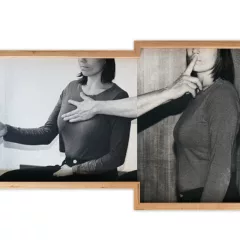Queer Voice, at the Institute of Contemporary Art (ICA ), University of Pennsylvania through August 1, 2010 is an exhibition organized around an idea: that a number of artists since the 1960s have created narrative or performance-based work that emphasizes the voice, the voice distorted or manipulated such that gender is divorced from sex and/or gender is undistinguishable: a queer voice. And this queer voice, in turn, establishes a queer or de-familiarized space for the audience. That the work of the nine artists does not clearly support this thesis, or that the thesis misses the most significant aspects of the work, in no way diminishes the exhibition’s interest; for the work is plenty strong enough to stand without theoretical props.
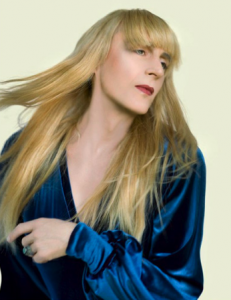
I was bowled over by John Kelly’s work: Compilation and Commentary (2010) a video of excerpts of 11 performances Kelly did between 1984 and 2009 and a separate audio narrative by the artist, a voice-over that one can choose to hear along with the video, or not, through earphones. Kelly began as a dancer but in his own performances he also sings. In the voice-over he situates each piece in terms of where he was performing, what he might have been asked to do, and his feelings at the time. This, combined with a twenty-year time span results in a fascinating narrative of a career that began with more ambition than training, and along the way acquired technical skills and ever more introspection, but never became tame.
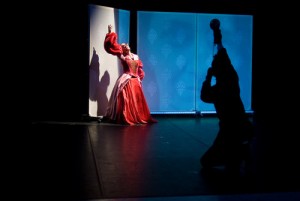
You can perfectly well ignore Kelly’s own story and focus on his performances, many in drag, where he personifies a series of individuals, some real and others fictitious: Mona Lisa, Joni Mitchell, Egon Schiele and, most spectacularly, Maria Callas. He is supremely musical, funny, camp, insightful, outrageous, literate, and has a body as musical as Frank Sinatra and as expressive as Charlie Chaplin. The man is a genius, and his performances can best be described in the words of Jean Cocteau: the lie that tells the truth. Kelly communicates profound emotional truths through the unlikely medium of parody. And more than anything, Kelly communicates love: love for the music, for performing, for his audiences, his characters and for the real people behind them.
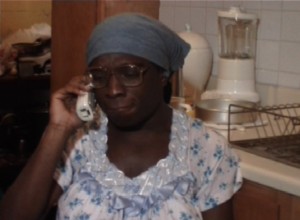
Kalup Kinzy also expresses emotional truth beneath his format of a home-made mock soap opera in which he plays all the characters in a family, most of them female: grandmother, mother, sisters and a gay son who is often shown cross-dressing. The multi-part (one audio, six video) Conversations wit de Churen (2002-09) verges on slapstick parody when we recognize the actor playing a man as Mickalene Thomas, a gay woman; or when we are not entirely sure whether Linzy (moustached and in women’s clothes) talking on the phone with the homely, bearded brunette in the lamé dress are supposed to be women or cross-dressing men. The illusion isn’t convincing either way, which is part of Linzy’s humor and his seriousness. For despite the unconvincing appearance of the characters, their conversations, many carried on via telephone (text-messaging would hardly work) are certainly real and familiar to us in the banality of their language and their universal expressions of pain, desire, ambition, uncertainty, anger, responsibility, and all the other emotions associated with family and social life.
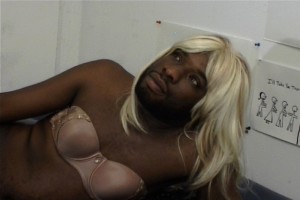
Laurie Anderson, in a white, mannish suit and spikey hair speaks in the (male) voice of power in O Superman (for Massenet) (1981); but the gallery’s small video screen conveys little of the power and theatricality of her actual performances, which were even more striking in their visual effects before the ubiquity of music videos. If you want to try out Anderson’s electronically-altered vocal effects, the ICA has provided equipment in the gallery. Two videos by Harry Dodge and Stanya Kahn depicting small groups of people in purposeful but incomprehensible activity struck me with their cultish and survivalist aspects; perhaps it’s that they are shown completely cut off from all other human activity, but I suspect in All Together Now (2008) it’s largely due to the obsessive but pointless group activities. It also reminds me of some 1960s black humor, such as Richard Lester’s film, The Bed-Sitting Room (1969), set in a post nuclear landscape where Ralph Richardson wanders around a destroyed London, worrying that he’ll become a bed-sitting room (he does).
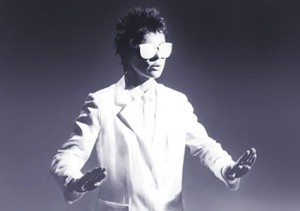
Ryan Trecartin is showing part of the latest installment of his epic Any Ever, sited in a black box almost entirely taken up by two large beds on metal bed-frames. Unlike the chaotic and evocative futurist/industrial or neo-Dogpatch decor (does anyone remember Li’l Abner?) of his previous installations, this mostly brings to mind a room in the attic set up when all of the cousins have decided to visit at once. The video, P.opular S.ky (section ish) (2009) follows characters from the earlier videos as they again fall down the rabbit hole of cyberspace and into a thoroughly digitized and manipulated world where platinum blondes really do have more fun. The script is more straight-forward and lacks the antic wordplay with stock phrases and jargon that I associate with Trecartin, but is still perfectly keyed to our endlessly plugged-in, recorded and multitasking world.
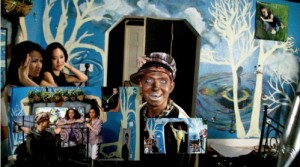
Sharon Hayes’ audio work accompanied by a poster, I March In The Parade Of Liberty, But As Long A I Love You I’m Not Free (2007-08) records a performance in the streets of Manhattan in which the artist, acting out the idea that the personal is political, recites a poignant letter to her former female lover, speaking through a bullhorn. While the ubiquity of cell-phones means we are constantly bombarded with other people’s intimacies in public spaces, they, at least, operate under the fiction of privacy. That Hayes would broadcast her rather lyrical sentiments of love lost in the face of society’s opprobrium is a remarkably moving political statement.
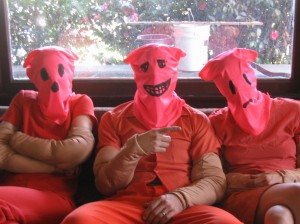
Sound tapes of Andy Warhol’s everyday activities may record his literal voice, but are considerably less interesting than the treasure trove of everyday life that he left in the form of time capsules: boxes of stuff and ephemera which the artist obsessively collected and the Warhol Museum is slowly opening, archiving, and putting on display. And his everyday speech, queer though it may be, holds up poorly in the midst of the seriously-conceived pieces that surround it. The initial work in the show are sound tapes of the highly influential film-maker and performer Jack Smith. A handy couch is available for comfort in listening (seats are provided for all the longer work), but try as I might I could not hear the tapes over the ambient noise of the Hayes and Kelly pieces. I’m truly disappointed; people with more acute hearing may get something from it.
I haven’t mentioned the long, narrow table cases for each artist (or pair), displaying their scripts, some with manuscript corrections. These may interest the class on transcription involved in the exhibition, and will probably interest writers and performers who will also likely appreciate the catalog. The cases contribute to the architecture of the installation but their contents offered me no useful content; I came to listen and look, not read. This comes back to the exhibition’s thesis; perhaps I’m too dull to get it.
The catalog includes both scripts by and transcriptions of all the artists, as well as more than eighty responses to the request, describe the Queer Voice which curator Ingrid Schaffner posed to art world colleagues. Readers unused to Hebrew may find more novelty in the fact that the catalog begins in the back and works its way forward, reversing the convention for books in English, although retaining English convention for each double-page spread. The exhibition was curated by Schaffner with Lucy Gallun, who coordinated the catalog.
This is an exhibition to be appreciated on many levels, filled with serious, provocative work. If you can follow its thesis, consider that a bonus. But go.





